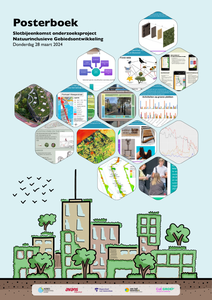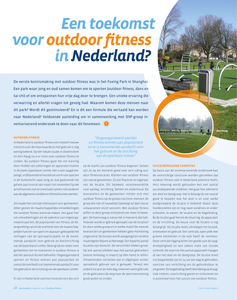Uit het voorwoord van Erlijn Eweg: Het bruist op De Uithof. Tienduizenden studenten en medewerkers van Hogeschool Utrecht, de Universiteit Utrecht en het Universitair Medisch Centrum Utrecht zijn er aan het werk. Er zijn grote plannen met het gebied, dat zich ontwikkelt van universiteitscentrum De Uithof tot het Utrecht Science Park, waar bedrijven en kennisinstellingen samen werken aan kennisvermeerdering. Een duurzame aanpak staat daarbij hoog op de agenda. De omslag naar een duurzame samenleving is een speerpunt van Hogeschool Utrecht (HU). In het speerpuntprogramma ‘De Omslag – duurzame ontwikkeling met Utrechtse energie’ versterken we duurzaamheid in onderzoek en onderwijs, samen met partners en externe partijen. Met het programma De Omslag als katalysator werken studenten en medewerkers van de HU aan duurzame oplossingen. De HU maakt samen met andere ‘bewoners’ van De Uithof deel uit van de kerngroep Duurzame Uithof. Deze kerngroep wil De Uithof verduurzamen op de terreinen energie, gebouwen, mobiliteit en water. Daarom is de technische faculteit van de HU in het collegejaar 2010-2011 van start gegaan met het project De Duurzame Uithof, onder leiding van Wilko Planje, projectleider. Het project is mogelijk gemaakt door de Gemeente Utrecht. Er zijn vier werkgroepen ingericht, voor ieder thema één. Iedere werkgroep wordt begeleid door een docent. Studentenprojecten en toepassingsgericht onderzoek leidden zo tot bruikbare aanbevelingen voor onze partners. In dit boekje vertellen we u er meer over.
DOCUMENT

Amsterdam Science Park (ASP) is a pearl in the crown of the Amsterdam knowledge economy, with its high-level research institutes (the Faculty of Science of the University of Amsterdam, several institutes of the NWO, the Dutch national science organisation) and a growing number of knowledge-based companies that reside in the multi-tenant Matrix buildings at the park. At ASP, the number of examples of co-creation is steadily growing. Larger tech firms (including Bosch and ASML) have located there and engage in deep collaboration with university institutes. Many more companies have expressed interest in collaborating with researchers located at ASP, not only in order to gain access to promising talent, but also to more extensively involve university researchers in their R&D processes. Another trend is the growth of science-based start-ups, now hosted at ASP’s Start-up Village: an appealing hotspot, made of sea containers. Players from business and university signal a rising need for new and more integrated concepts that facilitate collaborations between larger firms, start-ups and research groups. And also, the ASP management would like to see more co-creation. From its spatial and organisational design, the park is however characterised by a separation of activities: each faculty and institute operates its own building and facilities, with the firms hosted in the multitenant Matrix buildings. ASP is being developed along the lines of a masterplan based on strict zoning (Gemeente Amsterdam, 2013). This study explores how, and under what conditions further co-creation could be facilitated at ASP.
DOCUMENT

Programmed control systems are ubiquitous in the present-day world. In current educational practice, however, these systems are hardly being addressed, and little is known about children’s spontaneous understandings about such systems. Therefore, we explored pupils’ understandings prior to instruction in three concrete settings: a car park, an elevator, and an autonomous robot. We analysed written responses from 49 Grade 3 (aged 7 to 10) and Grade 6 pupils (aged 10 to 13) to assess their understandings from two perspectives: the user and the system programmer perspective. Results indicate that most pupils were capable describing programmed systems from a user perspective point of view but found it hard to describe the system programmer perspective. Substantial differences were found between the contexts. The car park context evoked richer descriptions for the user perspective and the system programmer perspective in comparison to the elevator and autonomous robot contexts.
LINK
Report in English on the results of the international Master Class by Stadslab on intercultural park design. The case described is a design for for a park in Eastern Ukrainian city of Melitopol. A redevelopment strategy is proposed for its historic Gorky Park (1936). The book also contains essays by intercultural cities expert Phil Wood and introductions by Marc Glaudemans, Beatriz Ramo and Olexandr Butsenko.
DOCUMENT

During this presentation, attendees will gain insights into how three years of intensive scientific research on dark rides, led by Dr. Wim Strijbosch and Dr. Pieter Cornelis, translate into practical implications. Through the examination of 250 dark rides across 75 criteria, attendees will grasp how the dark ride experience is carefully crafted as a staged experience for guests. Additionally, they will delve into a qualitative inquiry revealing two primary experiential trajectories, inward-driven and outward-driven, and learn how guests navigate these trajectories based on their motivations, opportunities, and abilities. Attendees will also discover key components shaping the dark ride experience, including emotion, imagery, and narrative-related states such as narrative transportation, presence and flow.
DOCUMENT
Boven titel staat vermeld: De symbiose van biologie en technologie. Zowel vanuit het Applied Science onderwijs als vanuit het werkveld kwam er meer vraag om biologische expertise toe te voegen aan het bestaande lectoraat Thin Films & Functional Materials.
DOCUMENT

In het SIA-project Natuurinclusieve Gebiedsontwikkeling onderzochten vier hogescholen - Aeres Hogeschool, Avans Hogeschool, Hogeschool van Amsterdam enHogeschool Van Hall Larenstein - drie schaalniveaus van gebiedsontwikkeling om de transitie naar natuurinclusieve gebiedsontwikkeling te versnellen. Gekoppeld aan driecasussen waren dit: gebouw (Spoorzone Waarder), straat (Knowledge Mile Park - KMP - Amsterdam), en gebied (Almere Centrum-Pampus).Tijdens de slotbijeenkomst van het project was er een posterexpositie georganiseerd waarbij op de posters de belangrijksteuitkomsten van diverse deelonderzoeken werden gepresenteerd. De posters van onderzoekers en studenten zijn in deze publicatie gebundeld.
DOCUMENT

The purpose of the design-based research reported here is to show – as a proof of principle – how the idea of scaffolding can be used to support primary teachers in a professional development programme (PDP) to design and enact language-oriented science lessons. The PDP consisted of six sessions of 2.5 h each in which twelve primary school teachers took part over a period of six months. It centralised the language support that pupils need to reason during science lessons. In line with the idea of scaffolding, the structure of the PDP targeted teachers' gradual independence in designing lessons. The first research question is how scaffolding was enacted during the PDP. The analysis of video recordings, field notes, researcher and teacher logs, and teacher design assignments focused on the enactment of three scaffolding characteristics: diagnosis, responsiveness and handover to independence. The second research question concerns what teachers learned from the participation in the PDP that followed a scaffolding approach. The data analysis illustrates that these teachers had learned much in terms of designing and enacting language-oriented science lessons. In terms of diagnosis and responsiveness, our PDP approach was successful, but we problematise the ideal of scaffolding approaches focused on handover to independence.
DOCUMENT

De eerste kennismaking met outdoor fitness was in het Fuxing Park in Shanghai, een park waar jong en oud samen komen om te sporten (outdoor fitness, dans en tai-chi) of om ontspannen hun vrije dag door te brengen. een unieke ervaring die verwarring en allerlei vragen tot gevolg had. waarom komen deze mensen naar dit park? wordt dit gestimuleerd? en is dit een formule die vertaald kan worden naar nederland? voldoende aanleiding om in samenwerking met DSP-groep inventariserend onderzoek te doen naar dit fenomeen.
DOCUMENT

Human and plant relationships are described within the rich tradition of multispecies ethnography, ethnobotany, and political ecology. In theorizing this relationship, the issues of functionalism, and interconnectivity are raised. This article aims to re-examine the position of plants in the context of contemporary urban spaces through the prism of environmental ethics. Despite conceptual plurality and socio-cultural complexity of human–plant relationships, social scientists fail to note how the perception of ‘greenery’ has objectified plants in urban environment. Without seriously considering bioethics, theories of human–plant relationship might fail to note exploitive anthropocentric relationship between humans and plants in urban spaces. The article is inspired by reflections of urban flora in Amsterdam, The Netherlands. https://doi.org/10.1016/j.scs.2013.01.007 https://www.linkedin.com/in/helenkopnina/
MULTIFILE
